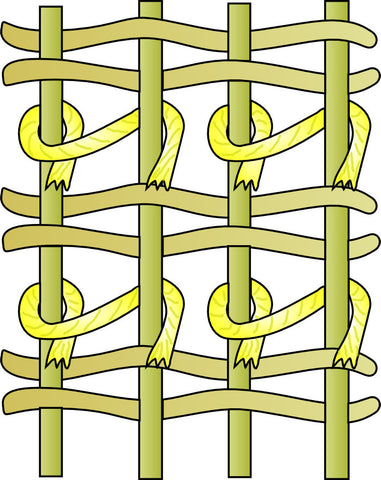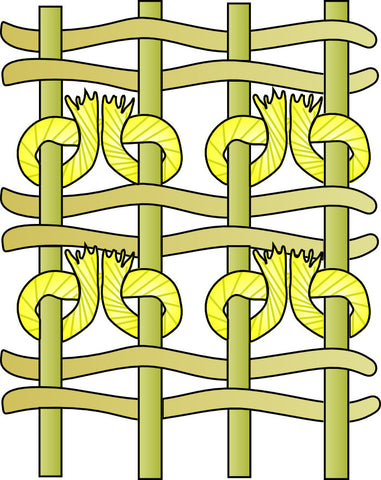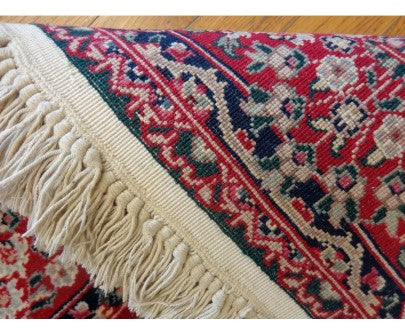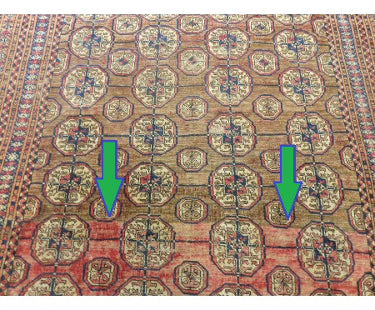Generally, Oriental rugs are defined as any rug made in a broad geographical area stretching from the Atlantic Ocean to the Pacific.

Oriental Rugs
To label an Oriental rug as antique, semi-antique or new, the guidelines are generally as follows:
Antique: 100 years or older, but can also be used to generally describe anything older than 70 years.
Semi-Antique: Generally between 20-70 years old
Modern or new rugs are generally less than 20 years old.
Oriental rugs are either flat-woven or hand-knotted. In hand-knotted rugs there are two main types of knots:

Persian Rug Knot (Original Image)

Turkish Rug Knot (Original Image)
The material used most often in Oriental rugs is wool. Goats hair, camels hair, cotton and silk are also used, however they are not employed as often. Cotton is primarily used as the foundation of Oriental rugs because it is firm, strong, and does not buckle. You will find other materials, like wool or silk, to also be used as foundation materials.
The factors which generally count towards making a rug more, or less valuable include: the fineness of the weave, the quality of the materials used, the richness of the dye, the design, the condition, and the age. The weave of an Oriental rug can be seen from the back of the rug, which is why so many dealers look at the back. The more intricate the design is, the more definition you will see on the back of the rug. Tighter knots on the back of the rug indicate a better weave. Coarsely woven rugs will have thicker knots and less definition in the design.
Which of these rugs has a finer weave?


If you think the first rug has a finer weave, you would be correct. The design of the first rug is very crisp and clear from the back, whereas the second rug is less clear and coarsely woven. The knots in the first rug are much smaller and tighter which increases the KPSI (knots per square inch). Again, the fineness of the weave is only one of the factors used to determine value of a rug; you may find you have a very valuable rug with a lower knot count.
Almost all rugs made before 1900 were made using vegetable dyes for color. After 1920 synthetic dyes became predominantly used as the demand for rugs was constantly increasing. Synthetic dyes fade at different rates. Rugs made with vegetable dyes commonly have abrash. Abrash is the term given to areas of color that differ in tone from the rest of the rug. This is caused when the wool is dyed at different times with vegetable dyes. The dye may come out darker or lighter based on the time the wool was dyed. The abrash may appear in large or small quantities in the rug as seen below. Some manufacturers have also mimicked abrash in their rugs with synthetic dyes.

Antique Caucasian Shirvan Rug with a darker strip of abrash.

Antique Turkoman Bokhara Rug with a unique large area of abrash.
Oriental Rug Producing Countries
Iran
Some common characteristics of Persian rugs include a large size, and intricate floral patterns woven in glowing colors, often with a central medallion. Carpets woven in central Persia tend to be the most characteristic of all Persian rugs. Carpets woven in the Southern and Eastern regions tend to have all-over pear-like patterns.
Iranian rugs are usually named after the city or district they were made in. The majority of them have a wool pile on a cotton foundation; however several districts have coarser rugs or silk rugs. Most rugs produced in Iran are made with Persian knots; some made in the Northwestern region of the country are woven with Turkish knots. If you have a solid knowledge of the characteristics including color, design, material and weaving technique that are found in each region than you should be able to identify the source of most Iranian rugs. Although identifying Iranian rugs can become difficult as many other countries imitate them.
Turkey
Turkey has had a rug making tradition as long as Persia has. There are several distinguishing features of Turkish carpets. They always incorporate the Turkish knot, the warp and weft threads of all carpets made before or around 1870 were wool or goat hair (since then cotton has been used), Turkey carpets are commonly geometric in nature and are woven with rich colors, and many Turkish carpets that are prayer rugs have distinctive mihrab shapes.
Nomads and villagers weave less sophisticated traditional patterns, while formal styles are created in workshops and factories similar to Iran. See our Guide to Persian Rugs for more information on Iranian rug weaving. Most traditional style Turkey carpets are named for the city or region in which they were first made, similar to Persian carpets. Turkish rugs are usually woven on a wool or cotton foundation and the pile is usually made with good quality wool. Silk/mercerized cotton can be used for the pile or foundation occasionally. Today, the majority of Turkey rugs are exported to Europe, while not many are exported to the USA.
Russia/USSR
The Caucasus Mountains are a region between the Black and Caspian Seas that adjoins both Turkey and Iran. Until the 19th century, the Caucasus was part of the Persian Empire who ceded it to Imperial Russia. The word Armenian is often used in older books as a synonym for Caucasian which can be misleading.
While the region was under Persian rule, its weavers maintained older traditions using bright colors and strong geometric patterns along with human and animal figures rather than adopting the curving designs and floral imagery of Iran. Caucasian rugs are usually woven with the Turkish knot. In older rugs the foundation was almost always wool whereas modern rugs employ cotton foundations. The Karabagh has particularly crude floral designs and the Shirvan is more floral than usual for a Caucasian rug. Nearly all Caucasian rugs tend to be bright and colorful and it is rare to find them in large sizes. Many Caucasian carpets use bold, primitive geometric forms.
The Caucasus have produced very distinctive rug types since at least the end of the 18th century. The colors of Caucasian carpets over 100 years old or more were produced from natural materials found in the respective tribal regions such as plants, herbs, roots, minerals, insects and mollusks. These colors included deep greens, vibrant yellows and deep rose tones.
China
The earliest surviving examples of Chinese rugs have been dated to the 17th century at the end of the Ming dynasty. Persian influence grew in the Chinese carpet industry from the early 18th to mid-19th centuries. During the mid-19th century Chinese weaving came under the influence of European and American markets. These rugs had Chinese motifs such as dragons, cranes, and fret designs. In the period between the two World Wars, China was exporting rugs that copied Persian, Turkish, Turkoman and Caucasian designs, as well as rugs in the Art Deco style. This style features large, colorful figures (sometimes vases of flowers) set on plain colored fields framed by solid borders in contrasting colors.
Afghanistan
Rugs from the area of Turkestan which formerly included the three Soviet States of Turkmen, Uzbek, and Kazakh are generally known as Turkoman. Turkoman carpets are also woven in Afghanistan. The Persian knot is primarily used in this area. Afghan-style rugs have more characteristics in common with the nomadic weaving of Central Asia than they do with sophisticated Iranian carpets. The majority of rugs from Afghanistan are made by rural villagers and nomadic tribesmen, although some do come from established weaving centers.
Designs from Afghanistan will rarely show animal or human forms due to religious beliefs, but do have identifiable geometric styles in dark, somber colors. The most popular styles include the Ersari, Bokhara and the Belouch. Learn more about Bokhara rugs.
Pakistan
Pakistan and India were once united under the Mogul and British empires. After the Second World War, both weaving industries went in different directions. The rug industry in Pakistan was booming by the early 1960’s after the Moslem and Turkoman weavers united in Pakistan. Rugs made in Pakistan come from two sources including: individual Pakistani weavers who own their own looms and enter into contracts with exporters who supply them with designs and materials and large factories that produce Oriental rugs in large quantities. Bokharas are one of the most common rugs woven in Pakistan. Learn more about Bokhara Rugs. Pakistani rugs are almost always woven with Persian knots on cotton warps. Many of these rugs have a high pile.
India
Rug weaving came to India around the 16th century during the time of the Moguls. This influence of Persian culture was incorporated into the rugs woven in India. India produced some of the greatest carpets ever woven in the late 16th and early 17th centuries. After the rise of British India, rug weaving was on a decline until demand increased at the end of the 19th century. Many of the rugs made in India from this period to around WWII were much cruder and woven with lower quality materials. Manufacturers in India began improving the quality of their rugs after around WWII.
Because of the climate in India there is a very low domestic demand for wool rugs, therefore many of the carpets woven there are solely woven for export. The names of Indian rugs are chosen arbitrarily and have no geographical significance. Popular, inexpensive rugs from India include the flatweave dhurrie, and the Kashmir. The pile of Indian rugs is sometimes carved or embossed where different colors and designs meet which gives the rug more depth. Better quality Indian rugs have design elements outlined with knots in a darker or contrasting color.
Romania
Rugs woven in Romania are woven on either cotton or wool foundations with primarily Persian knots. The native wool is of very good quality. Romanian rugs are named for towns, rivers and mountains. The names of Romanian rugs classify the quality of the rugs by knot count. These rugs have designs similar to classic Persian rugs and Caucasian rugs as well as variations on these classic designs.
Spain
Spanish rugs are woven with wool pile on cotton foundations. These rugs are rare and are desirable for their appearance. They are often woven with subtle color changes to copy the look of older rugs. Designs and colors are usually copies of classic Persian and Turkish rugs. Spanish rugs include a unique method in which knots are tied on every other single warp. This type of weave is not used anywhere else.
Taiwan
Rugs made in Taiwan almost always mimic classic Chinese patterns, in particular the Peking design is most popular. These rugs are usually of decent quality. The colors are usually traditional, but Taiwanese rugs are also available in rich deep backgrounds or in softer shades.
Other rug producing countries include Yugoslavia, Bulgaria, Tibet, Egypt, Greece, Mexico, Morocco, Tunisia, and Poland among others. The output of rugs from these areas is relatively small compared to the others listed here.
Sources:
(1) Jerrehian, Aram K. Jr. Oriental Rug Primer; Buying and Understanding New Oriental Rugs. Pennsylvania, Running Press, 1980. Print.
(2) Bennett, Ian. Book of Oriental Carpets and Rugs. New York, The Hamlyn Publishing Group Limited, 1972. Print.
(3) Izmidlian, Georges. Oriental Rugs and Carpets Today, How to Choose and Enjoy Them. New York, Hippocrene Books, Inc, 1983. Print.
(4) Dake, https://en.wikipedia.org/wiki/File:Noeud_turc.jpg,https://en.wikipedia.org/wiki/File:Noeud_senneh.jpg
